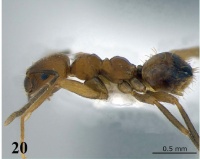Brachymyrmex brasiliensis
| Brachymyrmex brasiliensis | |
|---|---|

| |
| Scientific classification | |
| Kingdom: | Animalia |
| Phylum: | Arthropoda |
| Class: | Insecta |
| Order: | Hymenoptera |
| Family: | Formicidae |
| Subfamily: | Formicinae |
| Tribe: | Myrmelachistini |
| Genus: | Brachymyrmex |
| Species: | B. brasiliensis |
| Binomial name | |
| Brachymyrmex brasiliensis Ortiz & Fernández, 2014 | |
Biological and ecological information of this species is lacking.
Identification
This species differs from most other Brachymyrmex species by the presence of tumuliform metathoracic spiracles (see key for image of this character), and clypeus with five long, erect hairs arranged as follows: one central hair near to the anterior margin, usually conspicuous; one pair of lateral hairs at clypeus midlength and one pair of hairs near the toruli. Unique features for Brachymyrmex brasiliensis are the smooth and shiny gaster and, opaque head and mesosoma. (Ortiz & Fernández, 2014)
Keys including this Species
- Identification key to Brachymyrmex species
- Key to Brachymyrmex with tumuliform metathoracic spiracles
Distribution
Brazil: states of Goiás and Rio de Janeiro.
Latitudinal Distribution Pattern
Latitudinal Range: -3.98228° to -22.161242°.
| North Temperate |
North Subtropical |
Tropical | South Subtropical |
South Temperate |
- Source: AntMaps
Distribution based on Regional Taxon Lists
Neotropical Region: Brazil (type locality), Ecuador.
Distribution based on AntMaps
Distribution based on AntWeb specimens
Check data from AntWeb
Countries Occupied
| Number of countries occupied by this species based on AntWiki Regional Taxon Lists. In general, fewer countries occupied indicates a narrower range, while more countries indicates a more widespread species. |

|
Estimated Abundance
| Relative abundance based on number of AntMaps records per species (this species within the purple bar). Fewer records (to the left) indicates a less abundant/encountered species while more records (to the right) indicates more abundant/encountered species. |

|
Biology
Castes
Known only from the worker caste.
Nomenclature
The following information is derived from Barry Bolton's Online Catalogue of the Ants of the World.
- brasiliensis. Brachymyrmex brasiliensis Ortiz, C.M. & Fernández, 2014: 22, figs. 19-21, 28 (w.) BRAZIL (Rio de Janeiro, Goiás).
- Type-material: holotype worker, 1 paratype worker.
- Type-locality: holotype Brazil: Rio de Janeiro, Nova Friburgo, Fazenda Barreto, 22°9’40.4712’’S, 42°31’27.4866’’W, 1068 m., 11-12.vi.2011 (T.M.S. Mesquita); paratype with same data.
- Type-depositories: MZSP (holotype); UFUB (paratype).
- Status as species: Ortiz-Sepúlveda, et al. 2019: 475.
- Distribution: Brazil.
Unless otherwise noted the text for the remainder of this section is reported from the publication that includes the original description.
Description
Worker
Holotype measurements (mm) HL1 0.59; HL2 0.36; HL3 0.15; HW 0.53; SL 0.67; EL 0.11; WL 0.71; PnL 0.24; PnW 0.36; ML 0.15; MW 0.18; Indices CI 90; SI1 127; SI2187.5; OI 25. Paratype measurements (mm) HL1 0.59; HL2 0.36; HL3 0.15; HW 0.53; SL 0.67; EL 0.11; WL 0.71; PnL 0.24; PnW 0.36; ML 0.15; MW 0.18; Indices CI 90; SI1 127; SI2187.5; OI 25. Additional material examined (mm) HL1 0.61; HL2 0.40; HL3 0.15; HW 0.53; SL 0.68; EL 0.13; WL 0.73; PnL 0.24; PnW 0.36; ML 0.15; MW 0.18; Indices CI 89; SI1 129; SI2 187.5; OI 25.
Head slightly longer than wide. Posterior cephalic border slightly convex, sides slightly convex. Anterior clypeal margin rounded. Toruli touching the posterior clypeal margin but never surpassing it (best observed in anterodorsal oblique view). Scapes long, surpassing the posterior margin of the head. Ocelli present. Eyes located at cephalic midline and well developed with 11 ommatidia at their maximum diameter.
Promesonotum convex in profile, mesonotum strongly convex and separated from pronotum. Propodeum convex with short dorsum. Metathoracic spiracles fully dorsal, tumuliform, bulging out of the metanotal groove in lateral view. Propodeal spiracle round, separated from declivity of propodeum by a distance equal to the diameter. Petiole short, apex rounded and inclined forward.
Head and mesosoma finely punctate and opaque. Dorsum of head with some erect hairs on front and with scattered decumbent pubescence. Gaster smooth and shiny with several scattered erect hairs. Scapes with decumbent hairs that are shorter than the maximum scape diameter. Clypeus with five long, erect hairs arranged as follows: one central hair near to the anterior margin, usually conspicuous; one pair of lateral hairs at clypeus midlength and one pair of hairs near the toruli. Pronotum usually with two erect hairs, rest of mesosoma without hairs. Body light brown.
Type Material
Holotype worker (Museu de Zoologia da Universidade de Sao Paulo) [USNM 00757748] and Paratype worker (UFUC) [USNM ENT 00757833]: Brazil, Rio de Janeiro, Nova Friburgo, Fazenda Barreto, 22°9'40.4712"S, 42°31'27.4866"W, 1068 m, 11–12 Jun 2011, col. T.M.S. Mesquita.
Etymology
After Brazil, the country of collection, in honor of its very rich ant fauna.
References
- Ortiz, C.M. & Fernández, F. 2014. Brachymyrmex species with tumuliform metathoracic spiracles description of three new species and discussion of dimorphism in the genus (Hymenoptera, Formicidae). ZooKeys 371, 13-33.
- Ortiz-Sepulveda, C.M., Van Bocxlaer, B., Meneses, A.D., Fernández, F. 2019. Molecular and morphological recognition of species boundaries in the neglected ant genus Brachymyrmex (Hymenoptera: Formicidae): toward a taxonomic revision. Organisms Diversity & Evolution (DOI 10.1007/s13127-019-00406-2).
References based on Global Ant Biodiversity Informatics
- Ortiz-Sepuvelda C. M., B. Van Bocxlaer, A. D. Meneses, and F. Fernandez. 2019. Molecular and morphological recognition of species boundaries in the neglected ant genus Brachymyrmex (Hymenoptera: Formicidae): toward a taxonomic revision. Organisms Diversity & Evolution https://doi.org/10.1007/s13127-019-00406-2

